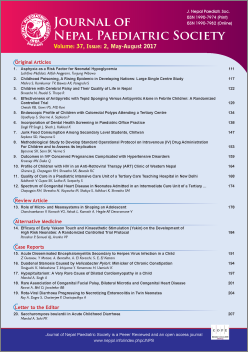Children with Cerebral Palsy and their Quality Of Life in Nepal
DOI:
https://doi.org/10.3126/jnps.v37i2.17124Keywords:
Cerebral Palsy, Quality of lifeAbstract
Introduction: Cerebral Palsy (CP) may affect individual’s everyday life and it may have significant impact on quality of life (QOL). The objective of this study was to assess the quality of life of children with Cerebral Palsy in Nepal.
Material and Methods: This is a descriptive cross sectional study that involved 42 children between 4 and 12 years of age. The Socio-demographic variables were obtained from interviews and CP related factors were obtained from medical reports. Validated CP-QOL child self-report and parent proxy version of questionnaire was used for data collection. Severity was assessed using Gross Motor Function Classification System (GMFCS), Manual Ability Classification System (MACS), Communication function Classification System (CFCS) and ICD-10 Classification System. Data were summarized using descriptive statistics. Kruskal Wallis and Man Whitney was used to find out association between Cerebral Palsy related factors and Quality of Life.
Results: 57.1% (n=24) were between 8 and12 years of age and 42.9% (n=18) were between 4 and 8 years of age. Overall QOL was reported to be fairly good. Both the child and Caregiver gave highest score on “Social wellbeing and acceptance” and “Emotional wellbeing and self-esteem domain” and Lowest Point in “Pain and Impact of disability”. This implies that Psychosocial Quality of Life is good in children with CP. Quality of Life as reported by child was better than Quality of Life reported by Caregiver.
Conclusion: Overall QOL is fairly good in children with CP. However, Pain and impact of disability impairs QOL.
Downloads
Downloads
Published
How to Cite
Issue
Section
License
Authors who publish with this journal agree to the following terms:
Authors retain copyright and grant the journal right of first publication with the work simultaneously licensed under a Creative Commons Attribution License that allows others to share the work with an acknowledgement of the work's authorship and initial publication in this journal.
Authors are able to enter into separate, additional contractual arrangements for the non-exclusive distribution of the journal's published version of the work (e.g., post it to an institutional repository or publish it in a book), with an acknowledgement of its initial publication in this journal.
Authors are permitted and encouraged to post their work online (e.g., in institutional repositories or on their website) prior to and during the submission process, as it can lead to productive exchanges, as well as earlier and greater citation of published work (See The Effect of Open Access).



